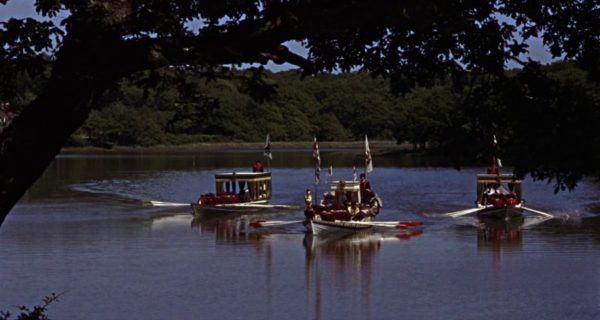The River Thames flows through the drama of A Man for All Seasons, providing transportation for Sir Thomas More, and informing the whole story with its living presence. As a member of the King’s Council and a judge in the court of requests, Sir Thomas sails the English River from his home in Chelsea to meetings in the City of London. He is summoned by boat to Hampton Court to hear Cardinal Woolsey’s plea that he help apply financial pressure to the church. The pressure would force a dispensation for the King’s divorce of Catherine of Aragon so that he could might marry Anne Boleyn.
We see the storied River’s tide bringing King Henry VIII to urge he cause and then again providing an excuse for him to leave, before dining, when Thomas opposes him. As a convenience to his personal life, and to gain absolute authority in England, Henry devises a new law making himself head of the Church. He commands his “true” subjects to sign an oath of allegiance. With the tide out, the mud of the Thames illustrates how shallow, false, and murky life under Henry VIII would be. We are shown how the courtiers, much to the King’s amusement, are twice forced to scramble through the muck and murky water in pursuit of him — so submerged and severed from conscience have their identities become under the corrupting influence of this monarch.
Snatches of the River’s natural history provide analogies to enrich our thoughts about its part in these happenings. Geologic history shows that the River, prior to 8,000 years ago, was a tributary of the Rhine. This was before the process of glacial melting and land subsidence had flooded the separating continental valley with the cold North Sea, becoming the English Channel and transforming what would become Great Britain into an island. A change of such immense scale provides a comparison for the massive perversion of conscience that the signing of Henry’s oath caused his subjects in their forced acceptance of him as head of the Church at England. The geological change created an island and isolated a river from its natural course, much as this usurpation of conscience severed a great continental religious belief.
The river boatmen in A Man for All Seasons were required to be licensed. Like today’s watermen on the Thames, they probably spent a seven-year apprenticeship, following the course of their fathers, learning of the River’s tidal changes and rate of flow. In one scene, as he steps aboard, Sir Thomas asks the boatman if he has his license, and is shown the device tied upon the man’s upper arm. This passing incident shows Sir Thomas’s concern for the law and implies his view of it as an instrument of safety. As the drama progresses, and his opposition to Henry remains steadfast, he is seen retreating into the refuge of safety which law has traditionally prepared.
Sir Thomas tells his daughter, who fears for his safety, that if the oath is worded in a way which will not violate his conscience, he will be able to sign it. But the wording was such to prevent this. When finally the boatmen refuse to carry Sir Thomas on the Thames to his home because they see him as a traitor, we know that safety under the law is gone from the kingdom. When his opposition will no longer be tolerated, Sir Thomas is forced to walk home to the wilderness.
In A Man for All Seasons we’re shown that Sir Thomas More believed he could have no identity apart from his conscience; that without it he would lose himself. In this final appearance of the River, the Thames provides an analogy for the new law of the King: it will not carry Saint Thomas More home, where his true identity lies.
~
The essay was originally published in print, Vol.VI, No. 2 of Caelum et Terra, under the name “The Thames and Saint Thomas More.” (My pen name at that time was Fay Davis.)

